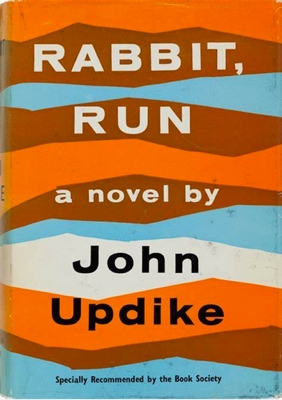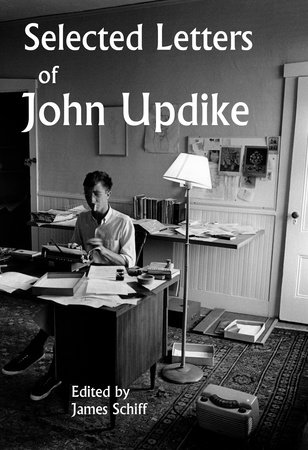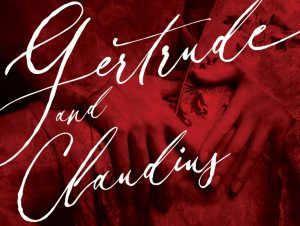
First U.K. Edition
The “about” tab says it all: “The concept of Colin’s Review is pretty self-explanatory. My name is Colin, and I review things. So, why should you care? Professional criticism is a dying industry. Ask any journalist or newspaper staff-writer and they’ll unfortunately tell you the same thing. However, there still exists a large contingency of readers who long for the golden era when criticism itself was just as artful as the topics the authors were reviewing. That’s what I strive to provide on this blog.”
So far he’s only reviewed four books (and Updike might be cringing somewhere to discover that Philip Roth’s Sabbath’s Theater merited an A while Rabbit, Run was awarded an A-), but Colin seems insightful, somewhat bold, and quite readable. In his review, after summarizing Updike’s first Rabbit novel in two sentences, Colin writes,
“It makes for a very funny premise, and when told through Updike’s extremely poetic and occasionally profound style, it makes for a very compelling read. After all, the masculine urge for escape is relatable to everyone. Or, rather, Updike’s such a talented writer that Rabbit’s masculine impulses are easy to empathize with. The further he self-destructs, the more human he becomes.
“Then again, Rabbit isn’t exactly the most likable protagonist . . . . Watching him constantly take advantage of those around him would be quite exhausting if it wasn’t for Updike’s wit and clarity. Not to mention the book’s present tense P.O.V., which keeps Rabbit’s cycle of assholery refreshing despite its repetition—an uncomfortable and entertaining read.
“Back in 1960, Rabbit, Run provided a fresh perspective: a window into the soul of American men disillusioned with the middle-class WASP lifestyle, searching for spirituality but lacking religion, obsessed with sex yet scared of commitment, desperate for meaning in a seemingly meaningless world. Admirable cowards, self-righteous fools.”
Colin notes that Updike had such an “immense” influence that “thousands of similar characters” have “taken up Rabbit’s running-away-from-family mantle. From American Pastoral to Cosmopolis to Five Easy Pieces, there’s no shortage of problematic white male protagonists. Then again, I can’t blame Updike for a half-century of imitators.”
The brisk review is made even brisker with sections on “Further Reading,” “Stray Observations (including Spoilers),” and “Quotes from Rabbit, Run.”

 Knopf, now a division of Penguin-Random House, just released cover art for Selected Letters of John Updike, edited by Updike scholar and John Updike Society vice-president James Schiff. The hefty hardcover (900 pages) is roughly 6×9″ and slated for October 21, 2025 release. A book release event and signing will be scheduled as part of the joint Roth-Updike societies’ conference in New York City, Oct. 19-22. Those who plan on attending should count on getting a copy in NYC.
Knopf, now a division of Penguin-Random House, just released cover art for Selected Letters of John Updike, edited by Updike scholar and John Updike Society vice-president James Schiff. The hefty hardcover (900 pages) is roughly 6×9″ and slated for October 21, 2025 release. A book release event and signing will be scheduled as part of the joint Roth-Updike societies’ conference in New York City, Oct. 19-22. Those who plan on attending should count on getting a copy in NYC. Of Updike’s novel she writes, “Mining, as did [Dorothy] Dunnett, some of Shakespeare’s own sources, Updike relied partly on Saxo Grammaticus’ twelth-century saga of Amlothi for details about the characters on which his Danish king and queen are based.
Of Updike’s novel she writes, “Mining, as did [Dorothy] Dunnett, some of Shakespeare’s own sources, Updike relied partly on Saxo Grammaticus’ twelth-century saga of Amlothi for details about the characters on which his Danish king and queen are based. Sixties’ icon Marianne Faithfull, a singer-songwriter who was considered a major figure in the so-called “British Invasion” of U.K. music to hit the U.S. during the turbulent decade,
Sixties’ icon Marianne Faithfull, a singer-songwriter who was considered a major figure in the so-called “British Invasion” of U.K. music to hit the U.S. during the turbulent decade,  Updike Society member Lang Zimmerman was reading Salman Rushdie’s Knife: Meditations After an Attempted Murder (Random House, 2024) when he came upon a second-chapter account of the birth of the PEN America World Voices Festival:
Updike Society member Lang Zimmerman was reading Salman Rushdie’s Knife: Meditations After an Attempted Murder (Random House, 2024) when he came upon a second-chapter account of the birth of the PEN America World Voices Festival: Jeff Werner, of
Jeff Werner, of  As his Reading Eagle
As his Reading Eagle  Displays will include founding documents, rare manuscripts, photos, cover and cartoon art, and artifacts on loan from other institutions–all intended to take visitors “behind the scenes of the making of one of the United States’s most important magazines,” according to City Life Org.
Displays will include founding documents, rare manuscripts, photos, cover and cartoon art, and artifacts on loan from other institutions–all intended to take visitors “behind the scenes of the making of one of the United States’s most important magazines,” according to City Life Org. Ditum reminded readers of the impetus behind Updike’s writing of the novel: “Jack Kerouac’s On the Road came out in 1957, and without reading it, I resented its apparent injunction to cut loose; Rabbit, Run was meant to be a realistic demonstration of what happens when a young American man goes on the road—the people left behind get hurt. There was no painless dropping out of the Fifties’ fraying but still tight social weave.”
Ditum reminded readers of the impetus behind Updike’s writing of the novel: “Jack Kerouac’s On the Road came out in 1957, and without reading it, I resented its apparent injunction to cut loose; Rabbit, Run was meant to be a realistic demonstration of what happens when a young American man goes on the road—the people left behind get hurt. There was no painless dropping out of the Fifties’ fraying but still tight social weave.”